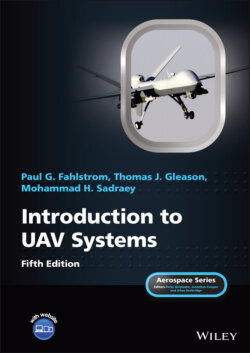Читать книгу Introduction to UAV Systems - Mohammad H. Sadraey - Страница 79
3.12 Flapping Wings
ОглавлениеThere is interest in UAVs that use flapping wings to fly like a bird. The details of the physics and aerodynamics of flight using flapping wings are beyond our scope, but the basic aerodynamics can be appreciated based on the same mechanisms for generating aerodynamic forces that we have outlined for fixed wings. The following discussion is based largely on Nature’s Flyers: Birds, Insects, and the Biomechanics of Flight [13].
The flapping of the wings of birds is not a pure up and down or rowing backstroke as commonly thought. The wings of a flying bird move up and down as they are flapped, but they also move forward due to the bird’s velocity through the air mass. Figure 3.20 shows the resulting velocity and force triangles when the wing is moving downward. The net velocity of the wing through the air mass is the sum of the forward velocity of the bird’s body (V) and the downward velocity of the wing, driven by the muscles of the bird (w), which varies over the length of the wing, being greatest at the wing tip. The resulting total velocity through the air mass is forward and down, which means that the relative wind over the wing is to the rear and up.
Figure 3.20 Wing flapping diagram
Figure 3.21 Flight of a bird
The net aerodynamic force generated by that relative wind (F) is perpendicular to the relative wind and can be resolved into two components, lift (L) upward and thrust (T) forward (Figure 3.21).
The velocity and force triangles vary along the length of the wing because w is approximately zero at the root of the wing, where it joins the body of the bird and has a maximum value at the tip of the wing, so that the net force, F, is nearly vertical at the root of the wing and tilted furthest forward at the tip. As a result, it sometimes is said that the root of the bird’s wing produces mostly lift and the tip produces mostly thrust. This is dissimilar to a fixed‐wing air vehicle, where the lift at the wingtip is almost zero, while at the wing root, it is often the maximum.
It is also possible for the bird to introduce a variable twist in the wing over its length, which could maintain the same angle of attack as w increases and the relative wind becomes tilted more upward near the tip. This twist can also be used to create an optimum angle of attack that varies over the length of the wing. This can be used to increase the thrust available from the wing tip.
Figure 3.22 shows how flapping the wing up and down can provide net lift and net positive thrust. The direction of the relative wind is tangent to the curved line that varies over the up and down strokes. To maximize the average lift and thrust, the angle of attack is “selected” by the bird to be large during the down stroke, which creates a large net aerodynamic force. This results in a large lift and large positive thrust. During the up stroke, the angle of attack is reduced, leading to a smaller net aerodynamic force. This means that even though the thrust is now negative, the average thrust over a complete cycle is positive. The lift remains positive, although smaller than during the up stroke.
The bird can make the negative thrust during the up stroke even smaller by bending its wings during the up stroke, as shown in Figure 3.22. This largely eliminates the forces induced by the outer portions of the wings, which are the most important contributors to thrust, while preserving much of the lift produced near the wing roots.
Figure 3.22 Wing articulation
This simplified description of how flapping wings can allow a bird to fly is as far as we are going to go in this introductory text. There are some significant differences between how birds fly and how insects fly, and not all birds fly in exactly the same way. In the early days of heavier‐than‐air flight, there were many attempts to use flapping wings to lift a human passenger. All were unsuccessful. As interest has increased in recent years in small, even tiny, UAVs, the biomechanics of bird and insect flight are being closely re‐examined and recently have been successfully emulated by machines.
